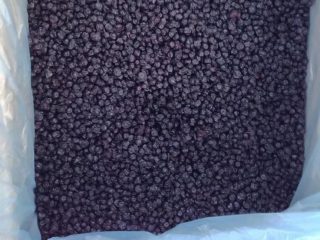Content
- 1 Is it possible to freeze rhubarb in the freezer?
- 2 How to properly freeze rhubarb
- 3 How to freeze rhubarb into cubes
- 4 Freezing blanched rhubarb
- 5 How to freeze rhubarb petioles with sugar
- 6 How to Freeze Rhubarb as a Puree
- 7 Freezing rhubarb in sugar syrup
- 8 How to properly store and defrost
- 9 What can you cook from frozen rhubarb?
- 10 Conclusion
Despite the variety of greens on supermarket shelves, rhubarb is not as popular on this list, and this is undeserved, since the plant contains an abundance of various vitamins and minerals. To provide yourself with this source of nutrients, the crop can be grown in your summer cottage, and to preserve vitamins for the winter, rhubarb can be frozen.
Is it possible to freeze rhubarb in the freezer?
In addition to its significant benefits for human health, rhubarb is valuable because it tolerates any type of heat treatment, including freezing. At the same time, exposure to cold temperatures has virtually no effect on the structure of the vegetable and does not in any way reduce its unique properties. Therefore, all cooks who want to feast on this useful plant should take note of several ways to freeze it. Rhubarb petioles can be frozen:
- bars;
- blanched;
- in sugar;
- in the form of puree;
- in syrup.
Although these freezing methods have their own nuances, some general rules that must be followed for high-quality processing of the product also apply to them.
How to properly freeze rhubarb
In order for rhubarb to retain the maximum amount of beneficial properties, it must be frozen correctly. The secret of a successful procedure lies in the careful selection of parts of the plant that will be frozen:
- Preference should be given to young rhubarb, since the old petioles of the plant have a high content of oxalic acid, which is harmful to the human body. The young parts of the vegetable have a delicate texture and bright color that varies from green to crimson, depending on the variety.
- It is most convenient to freeze petioles no thicker than 1.5 - 2 cm, the surface of which is smooth or slightly ribbed. Parts of rhubarb that are too prominent or thick indicate that the plant is old.
- When purchasing or collecting petioles, you should pay attention to their size. Rhubarb that reaches a length of more than 70 cm is most likely too old to be eaten.
- A damaged or wilting plant should not be frozen. It is better to use it in cooking or send it for processing.
Having chosen the best quality rhubarb, you should not immediately freeze it in the freezer, otherwise this may ruin the texture of the vegetable and affect its taste. It is necessary to prepare the product before putting it in the freezer:
- All parts of the plant should be washed with cold water and free of dirt before freezing. The washed raw materials must be thoroughly dried at room temperature so that the greens do not subsequently freeze.
- It is necessary to manually remove the top fibrous layer of the peel from the vegetable or get rid of the hard veins. Flexible juicy petioles do not need to be peeled.
- Make sure that all leaf blades are removed from the petioles.
- The diced parts of the vegetable must be placed on a baking sheet or tray in an even layer so that the pieces do not touch, otherwise they will freeze to each other.
- The baking sheet should be lined with a sheet of parchment paper in advance: this will make it easier to remove the petioles from the freezer. After which it must be placed in the freezer strictly horizontally, avoiding tilting the surface, for 2 - 3 hours.
- Then the frozen rhubarb is transferred from the baking sheet to special plastic trays or bags for freezing.
- If you plan to freeze rhubarb in containers, you need to leave 1 - 1.5 cm of empty space between the parts of the plant and the lid, since frozen products increase in volume.
- If using bags, you can squeeze out any excess air before sealing. This will save space in the freezer.
- The frozen date should be written on bags or trays of vegetables. This step will help determine the approximate expiration date of the products.
How to freeze rhubarb into cubes
Freezing fresh rhubarb in blocks is considered universal, since the petioles stored in this way can be used in the preparation of almost any dish. Freeze vegetables by following these steps:
- The washed and peeled parts of the plant are cut into small pieces of 1.5 - 5 cm.
- They try to make the bars the same size so that it takes less time to defrost each of them.
- The size of the rhubarb pieces depends on the dish in which they will be used, so it is worth deciding in advance for what purpose the vegetable will be frozen. Small cubes are better suited for filling baked goods and jam, large cubes will come in handy in compotes and garnishes.
Freezing blanched rhubarb
You can freeze rhubarb not only raw, but also cooked; it should first be blanched. Many people prefer this method to freezing in blocks, since the heat-treated vegetable, when frozen, better retains its texture and does not lose its color. Blanch rhubarb like this:
- Pour water into a large saucepan and bring to a boil over moderate heat.
- The prepared parts of the plant are cut into pieces and placed in a colander.
- Place a colander in a pan of boiling water for 1 minute.
- The hot vegetables in the colander are then immediately plunged into cold water for the same period of time.
- Next, the cooled chopped petioles are laid out on a paper towel to dry. After this, the product can be frozen.
How to freeze rhubarb petioles with sugar
Often, rhubarb intended for making desserts and sweets is frozen immediately in sugar.
For freezing using a similar method, 4 tbsp. finely chopped petioles you will need 1 tbsp. granulated sugar:
- The vegetable pieces are evenly sprinkled with a layer of sugar so that it completely covers the rhubarb.
- Then the parts of the plant are packaged in plastic bags and placed in the freezer for 3 - 4 hours.
- After the specified time, the bags are removed and the rhubarb is mixed manually without removing the petioles from the bag. This is done in order to separate the frozen parts of the plant from each other.
- After this, the vegetables are put back into the cold for storage.
How to Freeze Rhubarb as a Puree
To prepare mousses and sauces, it is convenient to freeze rhubarb by making a puree from it. For this:
- The prepared petioles of the plant are cut into pieces.
- Pieces of vegetables are placed in a blender and crushed until a thick mass of uniform consistency is obtained.
- The mass is stirred and distributed into small plastic containers. For this purpose, plastic glasses used for dairy products, such as sour cream or yoghurt, are usually used.
- Cover the containers with lids and put them in the freezer.
Freezing rhubarb in sugar syrup
Freezing a vegetable in sweet syrup, as in the case of sugar, helps not only preserve the valuable qualities of the product, but also protect it from spoilage. Thus, storing the plant in syrup prevents the petioles from drying out and oxidizing. In addition, this freezing method improves the taste of rhubarb and prevents it from losing its shape and color:
- Combine 500 ml of granulated sugar and 1 - 1.5 liters of water in a saucepan.
- Heat the mixture over medium heat, stirring continuously until it boils.
- When the liquid boils, continue stirring until the sugar is completely dissolved.
- The finished syrup is allowed to cool at room temperature, then put in the refrigerator for 1 - 1.5 hours.
- The chopped rhubarb petioles are placed in containers for freezing.
- Then the vegetable petioles are poured with cooled syrup so that the pieces are completely buried in it.
- The finished product is sent to the freezer.
How to properly store and defrost
Frozen rhubarb should be stored in completely sealed plastic trays, cups or sealable bags. It is better to place the vegetable in the lower compartment of the freezer, since the temperature there is the lowest. The shelf life of a product placed in such conditions will be from 10 to 12 months.
If there is a need to defrost the petioles of a plant, the most suitable place for this will be the level of the refrigerator, where the temperature is maintained from +2 to +5 °C. In addition, defrosting can be done at room temperature or in a microwave oven by setting the device settings to the appropriate mode.
What can you cook from frozen rhubarb?
Fans of culinary experiments can safely freeze rhubarb without fear for the quality of the vegetable: in this form, it is in no way inferior in taste and texture to the fresh version. Frozen food can be used to prepare the same dishes as raw food. Thus, rhubarb cut into bars is ideal for main courses, salads, compotes, kvass, preserves and jams. A vegetable drenched in syrup or candied will serve as a delicious ingredient for pies, jelly, marmalade and soufflé. Rhubarb puree makes an excellent base for creams, mousses, ice cream and milkshakes.
Conclusion
Obviously, freezing rhubarb is not difficult if you know the peculiarities of preparing the plant for the winter in this way.In frozen form, the product will remain as tasty and healthy as when raw, and will be suitable for use in any recipes that the culinary imagination is capable of.














